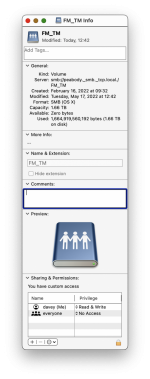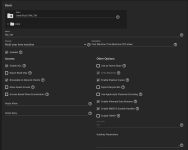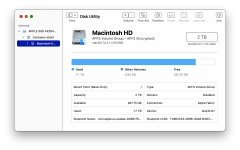Dave Hamby
Dabbler
- Joined
- May 16, 2017
- Messages
- 44
The MacOS volume being backed up is File Vault encrypted. The target dataset is encrypted. MacOS user Davey owns the target dataset and Davey is the MacOS admin. I can't find anything additional in the system console logs. The attached captures the MacOS Finder volume info and the SMB share configuration. The thrid image shows the Disk Utility info on the MacOS system volume being backed up. It appears MacOS thinks the Time Machine volume is full. I can't see an obvious cause.
Davey has a second dataset of music in the pool and can add new music to the music dataset. It's an iTunes format music library. iTunes is happy. So I know user name, user number, etc are not an issue.
I had intended to encrypt the TrueNAS pool Pool1 but missed that when commissioning the new Mini+. That hadn't been an issue before the update.
At this point, I'm out of ideas and need some coaching.
Thanks, Dave.
Davey has a second dataset of music in the pool and can add new music to the music dataset. It's an iTunes format music library. iTunes is happy. So I know user name, user number, etc are not an issue.
I had intended to encrypt the TrueNAS pool Pool1 but missed that when commissioning the new Mini+. That hadn't been an issue before the update.
At this point, I'm out of ideas and need some coaching.
Thanks, Dave.



